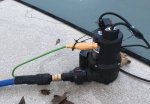For those who live in areas where the water in the discharge hose on your solid-cover pool pump can freeze, thus preventing the pump from performing its function, here’s the solution. Though not inexpensive, I purchased a Pirit (pronounced like pirate) heated hose. They were originally developed for use with RVs in the winter, but work quite well for this purpose. It is thermostatically-controlled (starts heating when the ambient temperature reaches 40°), and has heating elements extruded into the hose covering that run the entire length of the hose. It claims to be effective all the way down to -42°F .
I need this kind of protection since we leave for warmer climes for two months in the winter, and I’m not at home to monitor the situation, and correct a problem should it occur. Before I discovered this solution, the discharge hose did indeed freeze once, and the pump became useless.
The hoses are available in 12, 25, 50, and 100’ lengths. Use the shortest length you can, as the price increases dramatically with the longer lengths. I bought mine (25’) from Amazon and paid a little over $100.
Another recommendation: the female end of the hose, which you would ordinarily use to connect to the pool cover pump, is unfortunately also the one that has the 6’ cord to connect to 110v power. I say unfortunately because laying on a wet cover (possibly even occasionally submerged), this connection to your extension cord might well trip your circuit breaker. I solved that issue thusly: I installed a female-to-female hose adapter to the male end of the Pirit hose, and connected that end to the pump. The end that is now connected to the pump contains the thermostat, so to avoid the thermostat possibly being in the water, I zip-tied it to the top of the pump. That is shown in the photo, along with the use of the female-to-female hose adapter.
For what it’s worth, the pump is a Wayne WACP250 pump that has its blue base removed for the photo. My first pump was the Little Giant, and after 2 1/2 winters of multiple failures, I finally gave up and bought the Wayne pump, which has not failed me. I will say that periodically checking and clearing the internal weep hole in any pool pump is highly recommended to keep them running correctly. This is a simple 5-minute procedure which is probably only needed if you constantly have a lot of leaf debris or dirt on your cover.
I need this kind of protection since we leave for warmer climes for two months in the winter, and I’m not at home to monitor the situation, and correct a problem should it occur. Before I discovered this solution, the discharge hose did indeed freeze once, and the pump became useless.
The hoses are available in 12, 25, 50, and 100’ lengths. Use the shortest length you can, as the price increases dramatically with the longer lengths. I bought mine (25’) from Amazon and paid a little over $100.
Another recommendation: the female end of the hose, which you would ordinarily use to connect to the pool cover pump, is unfortunately also the one that has the 6’ cord to connect to 110v power. I say unfortunately because laying on a wet cover (possibly even occasionally submerged), this connection to your extension cord might well trip your circuit breaker. I solved that issue thusly: I installed a female-to-female hose adapter to the male end of the Pirit hose, and connected that end to the pump. The end that is now connected to the pump contains the thermostat, so to avoid the thermostat possibly being in the water, I zip-tied it to the top of the pump. That is shown in the photo, along with the use of the female-to-female hose adapter.

For what it’s worth, the pump is a Wayne WACP250 pump that has its blue base removed for the photo. My first pump was the Little Giant, and after 2 1/2 winters of multiple failures, I finally gave up and bought the Wayne pump, which has not failed me. I will say that periodically checking and clearing the internal weep hole in any pool pump is highly recommended to keep them running correctly. This is a simple 5-minute procedure which is probably only needed if you constantly have a lot of leaf debris or dirt on your cover.

